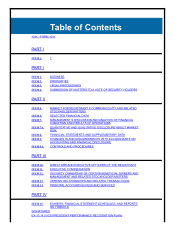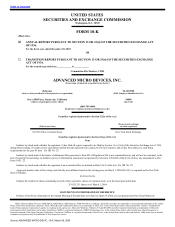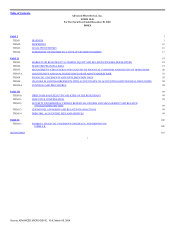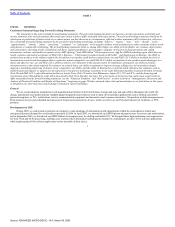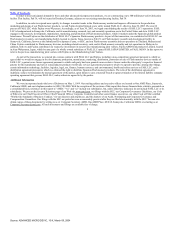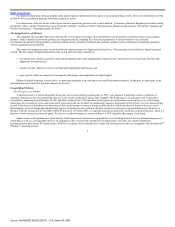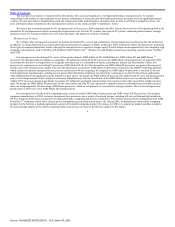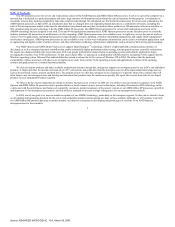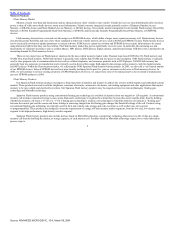AMD 2003 Annual Report Download - page 12
Download and view the complete annual report
Please find page 12 of the 2003 AMD annual report below. You can navigate through the pages in the report by either clicking on the pages listed below, or by using the keyword search tool below to find specific information within the annual report.
Table of Contents
manufacture and have simpler layouts compared to products based on single-bit-per-cell or multi-level-cell floating gate technology. As a result, MirrorBit
technology can contribute to a smaller die size and improved production yields. Due to these characteristics, for a given density, products based on MirrorBit
technology can be less expensive to produce than products based on conventional floating gate single-bit-per-cell or multi-level cell technology. We believe
MirrorBit technology gives us an advantage in the manufacturing of these products equivalent to one lithography node over multi-level cell solutions and two
lithography nodes over single-bit-per-cell solutions. Lithography is a process technology used in the manufacture of integrated circuits. In addition, we believe
MirrorBit technology enables the production of NOR Flash memory products at higher densities than are commercially viable using single bit-per-cell
technology.
Spansion Flash memory products using first-generation MirrorBit technology are manufactured using 230-nanometer process technology and are available
in densities ranging from 16 megabits through 256 megabits. In September 2003, FASL LLC announced the availability of engineering samples of the first 512
megabit NOR Flash memory product based on its second-generation MirrorBit technology. We believe this high density product will enable designers to create
large memory arrays, simplify existing designs by using only a single device, and reduce costs by migrating from floating gate technology-based products. In
2004, products based on second-generation MirrorBit technology will be manufactured using primarily 110-nanometer process technology. We believe
manufacturing costs for NOR Flash memory products based on MirrorBit technology that are manufactured using 110-nanometer process technology are similar
to or lower than manufacturing costs for comparable products based on conventional floating gate multi-level cell technology that are manufactured using
90-nanometer process technology.
Spansion Flash memory products implement different architectures to address different customer requirements. These different architectures may be
supported on floating gate technology as well as on MirrorBit technology. We address demand for lower-performance customer applications by providing
asynchronous access products with slower read speeds. We address demand for higher-performance products by providing advanced architecture products that
support faster burst-mode and page-mode read interfaces. Burst-mode products allow fast access to data in a continuous sequential operation, while page-mode
products allow fast random access to data within a page. The wireless market in particular currently demands such high-performance solutions. We intend to
continue to address the growing performance requirements of our customers in this market by expanding our product offerings and improving our products’
performance. In addition to a high-performance architecture, Spansion products may also include benefits such as Advanced Sector Protection, which improves
security, and simultaneous read/write, which improves system performance.
We also offer Flash memory in multi-chip packages, or MCPs, across a range of densities. Currently, the largest consumers of Flash memory devices are
mobile phone manufacturers. Mobile phone manufacturers require devices that allow them to make feature-rich products in small packages. They are especially
interested in MCPs due to the single, space-saving package, low power consumption, and high performance. Our MCP products incorporate Spansion Flash
memory devices ranging from 16 megabits to 128 megabits and non-Flash memory die, such as SRAM devices, which FASL LLC purchases from outside
vendors, ranging from two megabits to 64 megabits. We intend to continue to provide new products for this growing market, and we expect sales of MCP
products to increase in 2004 in comparison to 2003.
We believe that the key factors impacting our ability to increase Flash memory product revenues in 2004 are the continued market acceptance of MirrorBit
technology, our ability to maintain or increase average selling prices for Spansion Flash memory products, and growth in unit shipments of these Flash memory
products. In addition, FASL LLC’s ability to successfully transition to 110-nanometer process technologies for specified Flash memory products and its ability to
successfully increase manufacturing capacity at its fabrication, assembly and test facilities are key factors impacting our ability to increase Flash memory product
revenues.
7
Source: ADVANCED MICRO DEVIC, 10-K, March 09, 2004


